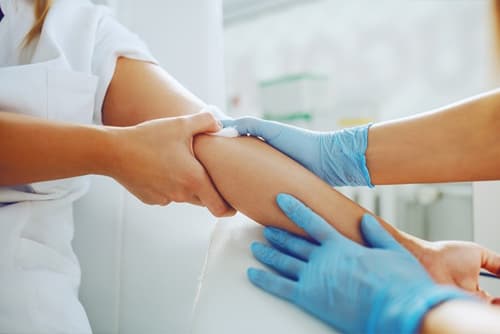Platelet Rich Plasma (PRP) Injection
Platelet-rich Plasma injections for joint arthritis and tendonitis are becoming a popular form of treatment in the field of regenerative medicine and are used to reduce pain and encourage healing.
Working together for a healthy life
What is a PRP?
PRP (platelet rich plasma) is a process whereby a sample of blood is taken from a patient’s vein. The blood is then spun in a centrifuge which causes the blood to separate into three different parts: red blood cells, platelets and plasma. The healing process of joints, tendons and ligaments is difficult due to the fact that this structures have limited blood flow. Injecting one’s own PRP directly to the injury site works by encouraging the growth and regeneration of new, healthy cells.
PRP therapies have been used for various indications for more than 30 years, resulting in considerable interest in the potential of autologous PRP in regenerative medicine.
PRP injections are delivered under ultrasound guidance to the area of pain and degeneration.
It is recommended to have 3 PRP injections with one-week interval between appointments.

Our focus is on the patient
The procedure of PRP

First consultation
Initially, the clinician who is performing the injection, will discuss the procedure and make sure this is the correct treatment plan for you, in regards to your medical history and symptoms. The clinician will screen you for any medical conditions which would prevent you having the treatment.

Preparation for the procedure
To avoid blood lipids (fats) in the PRP, the patient is asked to fast or follow a fat-free diet during the six hour prior to blood extraction. Also, the patient must be well hydrated prior to the treatment.

PRP Technique
Around 50ml of the patient own blood is taken from a vain in the arm. This amount is centrifuged at 1,200 rpm for 6-10 min and the platelet rich plasma portion is carefully collected in a syringe. The plasma is kept at room temperature and then, it is injected into the tendon or joint guided by an ultrasound scan. The ultrasound scanning provides accurate needle placement into the effected tendon.
Working together for a healthy life
What happens after the injection?
The patient is asked to stay seated for 15 minutes and is sent home with instructions to limit the use of the affected area for 24 hours, use Paracetamol for pain relief and to avoid NSAIDs (such as Ibuprofen).
A number of patients will experience some pain for a week or two after the injection. This is a normal side effect and usually nothing to be concerned about.
Due to pain in the injection site we normally advise to avoid driving. Therefore, the patient should consider arrangements for getting home after the procedure.
We recommend that patients have relative rest for 5-7 days after the injection. Avoiding strenuous exercise, heavy impact and loading activities for 2-3 weeks.
We usually treat using a series of 3 PRP injections, each injection is 2 weeks apart from next. If you are still experiencing post injection flare at 2 weeks we would post-pone for a further 2 weeks before next injection.
Further injections
The effects of PRP usually last around one year. The Procedure can be safely repeated if the patient found the PRP programme helpful.
Our focus is on the patient
Potential risks and side effects
PRP is autologous, which means it contains substances that come directly from the persons own body. This reduces the risks for an allergic reaction that can occur from injecting other medications, such as cortisone or hyaluronic acid. However, there are risks from the injection itself, including: infection, nerve injuries, pain at the injection site and tissue damage. The risk of infection is very rare, approximately 1: 50,000 injections. If the joint becomes very painful and hot, the patient is instructed to seek medical attention immediately, especially if they are feeling generally unwell.
The injection is performed by a qualified and experience clinician, under ultrasound guidance and therefore trauma to nerves or blood vessels are a very rare complication.


Good to know
FAQs
Unfortunately, we are not able to offer PRP injections to patients who are pregnant or breastfeeding. There is a lack of research into this area in order to robustly demonstrate that it is safe and entirely without risk.
Anti-coagulants: If a patient is taking a blood thinning drug, they would be advised to have a blood test to make sure that their blood is not too thin to have the injection. This is to reduce the risk of bleeding into the joint. NSAIDs (non steroidal anti-inflammatory drugs such as ibuprofen or naproxen): You can take other medicines with PRP injections, however, we recommend to avoid use of NSAIDs (non steroidal anti-inflammatory drugs such as ibuprofen or naproxen) for 1 week before, and 4 weeks after your treatment as this may have a negative impact on the treatment effect of the PRP injections.
Your treating clinician is trained to, and will take every appropriate step to avoid injecting or traumatising soft tissue structures, nerves or vessels when performing the injection. However, there is a very small risk that this can occur, particularly with injections at certain locations.
